

Supermassive black holes closest to Earth ever found set to collide, scientists say. Astronomers have discovered a pair of supermassive black holes that are the closest to Earth ever observed – and they're on a collision course with each other.
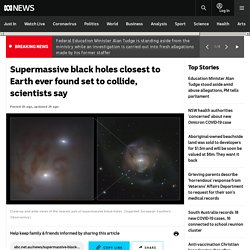
Located some 89 million light-years away (for context, one light-year is equivalent to about 9.47 trillion kilometres) in the galaxy NGC 7727, they're believed to be about 154 million time and 6.3 million times bigger than the Sun. Loading So what do we know about the discovery? And what does it mean for us Earthlings? They're closer to us (and each other) than we thought Using the European Southern Observatory’s Very Large Telescope (they really took naming duties in their own creative direction), researchers were able to make two key discoveries. First and foremost, they're a lot closer to Earth than anything we've seen before. Sure, you probably won't have to cancel your weekend plans given they're still 89 million light-years away, but when you consider the previous record was 470 million light-years, the discovery is significant.
Radiation from the Sun may be a missing source of water on Earth, new study suggests. Water is an essential ingredient for life on Earth.
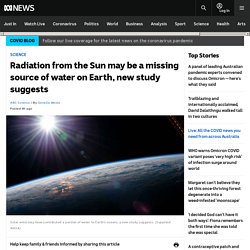
It is all around us in our oceans, rivers, clouds and our bodies. But where did it come from? Key points: About 71 per cent of the Earth's surface is covered in water, but we don't know where all this water came fromA new analysis shows it's possible that some of it could have come from the solar wind transforming dust particles While the dust on the debate about the origins of Earth's water is far from settled, the discovery has important implications for the Moon Some scientists argue that it was bound up in the rocks that glommed together as Earth was born out of a spinning disk of debris 4.5 billion years ago. Others believe Earth was dry for its first million years or so until it was bombarded by comets and asteroids bearing water.
But neither hypothesis can completely account for the amount or composition of water we see today on Earth. Light vs heavy water Getting down to an atomic level. Custom-designed space telescope could help fulfil Stephen Hawking's dream of reaching Alpha Centauri. Four light years is more than 40 trillion kilometres — it may sound like a long way, but when you're thinking astronomically, it's just next door.
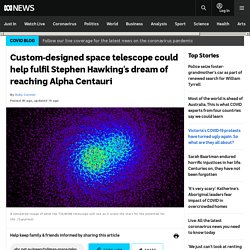
The TOLIMAN project is a joint partnership between Australian and US-based science institutes, including NASAIt is partly funded by an initiative set up by famed astrophysicist Stephen HawkingIt is hoped the space telescope will be launched in 2023 This is the distance a custom-designed space telescope created for a joint Australian-US space mission will span as it searches for habitable planets in the neighbouring Alpha Centauri system. The TOLIMAN telescope, an Arabic-derived name for the star system it'll be scanning, will utilise a diffractive pupil lens — a mirror which captures starlight to help detect the signs of habitable planets. SpaceX crew using incontinence pants on return home after toilet malfunctions.
The astronauts departing the International Space Station will be stuck using incontinence pants on the way home because of their capsule's broken toilet.
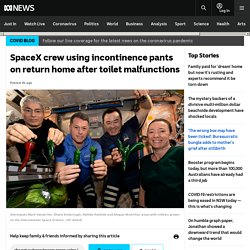
The broken toilet was first noticed in September, but has been deemed safe to fly homeCrew members returning to Earth this week will be wearing absorbent "undergarments"NASA astronaut Megan McArthur says the team is not worried about the inconvenience NASA astronaut Megan McArthur described the situation Friday as "suboptimal" but manageable. Australian artificial intelligence research to help astronauts grow plants in space. Within the next five years, astronauts will be growing vegetables on the moon with technology developed by Australian scientists.
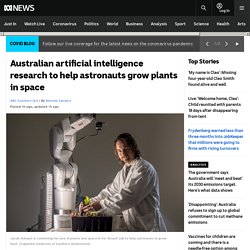
As NASA plans for human exploration of the Earth's moon by 2024, the ability to grow edible plants will be vital for the next steps in space exploration. In the lead-up to the new era in space, University of Southern Queensland (USQ) scientists are developing artificial intelligence (AI) for astronauts to use on missions from the moon to Mars to grow their own fresh food. Their mission is to develop agricultural tech software that will use sensors to detect early stress in plants being grown onboard space flights. "(We're) taking technologies that we've developed ourselves in broadacre cropping systems, using machine vision to look at the crop, determine how the crop is performing and provide that feedback to an astronaut so it just makes it simple for them to manage," USQ's Professor Craig Baillie said. Robot gardeners on the moon. China launches longest-ever crewed mission for space station construction.
China has launched a spacecraft carrying three astronauts, including one woman, to the core module of a future space station, where they are due to stay for six months, the longest duration in orbit for Chinese astronauts.

The launch begins the country's longest crewed mission to dateChina are barred by US law from working with NASAWith the ISS set to retire in a few years, China's space station will become the only one in Earth's orbit A Long March-2F rocket carrying the Shenzhou-13 spacecraft, which means "Divine Vessel" in Chinese, blasted off from Jiuquan Satellite Launch Centre in the north-western province of Gansu at 12:23am Beijing time. China began construction of what will be its first permanent space station in April with the launch of Tianhe — the first and largest of the station's three modules.
The astronauts Zhai Zhigang, 55, Wang Yaping, 41, and Ye Guangfu, 41, are to work and stay on Tianhe, the living quarters of the future space station, for six months. Reuters. Scientists confirm discovery of 'blazingly hot' planet, TOI-3362 b, with extreme seasons and rare orbit. An "extremely unusual" planet, with summer temperatures above 2,000 degrees and aluminium rain in winter, is teaching scientists how some of the hottest known gas giants were formed.
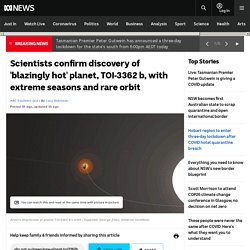
A team of international researchers, led by Pennsylvania State University, discovered the gaseous exoplanet TOI-3362 b about 200 light years from Earth. University of Southern Queensland astronomer Dr George Zhou was part of the team that recently confirmed the discovery. NASA personnel, Gumatj locals ready Arnhem Space Centre for historic, mid-2022 blast-off. Just inland from the north-east coast of Arnhem Land, dozens of personnel from the world's largest space agency are fine-tuning a rocket launchpad ahead of a historic mission.
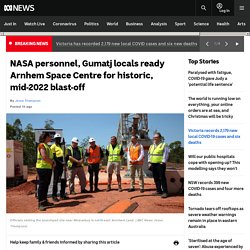
Almost 30 NASA scientists have been working with Gumatj locals on the site in north-east Arnhem Land near NhulunbuyThe first set of three rockets is expected to launch in the middle of 2022This project is expected to employ local Indigenous people for years to come In a deep thicket of tropical woodland, the small stretch of cleared Aboriginal land is valuable to the space industry because of its closeness to the equator and — as the NASA scientists have found out — it is incredibly hot. "We'd anticipated working 10-hour days, thinking it would be nice and easy, and around eight hours [we found] that's about enough before we needed to get into the air-conditioning. " Astronomers find Jupiter-like planet orbiting white dwarf star, in potential glimpse at our Solar System's future. A gas giant planet circling the remnants of a dead star has given astronomers a glimpse of what our Solar System might look like billions of years down the track.
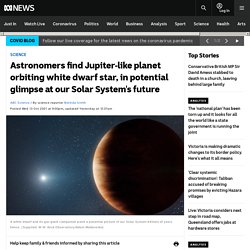
Key points: Astronomers have found the first planet-star pair that looks like how our Solar System is predicted to endIn about 5 billion years, the Sun will swell up and swallow the inner planetsThe finding shows Jupiter could survive the Sun's evolution into a red giant star The detection is the first to spot a Jupiter-like planet orbiting a white dwarf at a distance we might expect when a star runs out of fuel and dies. An international team of astronomers, including Joshua Blackman at the University of Tasmania, report their celestial revelation in the journal Nature today. Mysterious radio signals detected near centre of the Milky Way galaxy. What suddenly gets bright in the sky, sends out random radio signals and then disappears for months?
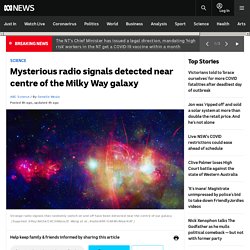
It's a question that has stumped astronomers since the discovery of a mysterious radio signal coming from near the centre of our galaxy in January last year. Key points: Astronomers have detected a strange radio signal seven times in nine months using the ASKAP telescope in WAThe signal has also been detected by the MeerKAT telescope in South AfricaThe astronomers are not sure what caused the signal, but it may come from a rare group of mysterious objects The signal is so strange it may be coming from a new type of celestial object, an international team of astronomers report in The Astrophysical Journal.
The team first picked up the signal while scanning the sky with the Australian Square Kilometre Array Pathfinder (ASKAP) radio telescope in outback Western Australia. Then the signal from the source dubbed ASKAP J173608.2−321635 disappeared, reappearing a couple of times a few months later. Moon rocks retrieved by Chang'e 5 mission show lunar volcanic activity 2 billion years ago. Back when life on Earth was no more than algae living in the oceans, thick lava gushed from long, gaping fissures on the Moon's surface, flooding the surrounding plains. Key points: The Chinese Chang'e 5 mission brought Moon rocks and soil to Earth in DecemberGeochemists analysed two fragments and calculated they were formed from lava 2 billion years agoThe study will help calibrate a crater-counting technique used for dating planetary surfaces across the solar system Last year, the Chinese Chang'e 5 lander scooped up some of that ancient lava flow — now solidified basalt — and brought it to Earth.
European and Japanese BepiColombo mission captures image of Mercury for the first time. A joint European-Japanese spacecraft got its first glimpse of Mercury as it swung by the solar system's innermost planet while on a mission to deliver two probes into orbit in 2025. The spacecraft took a photo as it flew within 200km of the planet's surfaceThe mission was launched in 2018Five further fly-bys are needed before BepiColombo slows enough to release space bots The BepiColombo mission made the first of six fly-bys of Mercury on Saturday morning AEST, using the planet's gravity to slow itself down. After swooping past Mercury at altitudes of under 200 kilometres, the spacecraft took a low resolution black-and-white photo with one of its monitoring cameras.
Launching Starship: Inside Elon Musk's plan to perfect the rocket to take humanity to Mars. In the pre-dawn light on a road that ends at Boca Chica beach in south-east Texas, rocket chasers are setting up cameras at the entrance to Elon Musk's Starbase. This is the production site for Starship, the next generation of SpaceX's orbital spacecraft. In a few hours, a nearly 70-metre high "superheavy" rocket will be rolled out from here 2 kilometres down the road for its test campaign to begin at the SpaceX launch site. "I don't think people understand, this is the largest most powerful rocket that's ever existed in human history," says MaryLiz Bender of the Cosmic Perspective YouTube channel.
"Much larger even than the Saturn 5 — more powerful — and so what we always try to do is gift the awe. " New meteor shower from comet 15P/Finlay predicted to occur for first time this week. If you are outside just after sunset tonight, you may catch a meteor out of the corner of your eye if you are very, very lucky. Earlier this year, scientists predicted Earth would pass through patches of dust left behind by a tiny comet known as 15P/Finlay, for the first time in late 2021. At best this meteor shower, dubbed the Finlayids, is not likely to be a dazzler. And it is just a prediction — albeit from some of the best comet scientists in the world — so there's a chance it may not happen at all. "We think we might see something, but nobody is really sure because it's never been seen before," says Jonti Horner, an astronomer at the University of Southern Queensland. Chinese astronauts return to earth after 90 days on space station.
Three Chinese astronauts are spending their first night on Earth in three months after completing the longest mission in the country's space program. Rocket catches fire during latest lift-off attempt at Whalers Way launch site on Eyre Peninsula. An anticipated rocket launch on South Australia's Eyre Peninsula has again been delayed after the rocket caught fire — but the company involved says the blaze was contained to the launch pad. UTAS student off to NASA after using gravitational microlensing to discover exoplanets. Deep in Tasmanian bushland, a discovery mission is underway. Key points: What you can expect to see from Australia during 2021's Perseid meteor shower. If you are anywhere north of Brisbane, you might be lucky enough to catch a meteor streaking across the sky in the early hours of tomorrow morning.
Entire supernova shock wave captured in detail by Kepler space telescope. Around a billion years ago, a massive yellow star exploded in the constellation of Cancer. Cameras capture footage of meteor lighting up sky over Norway. An "unusually large" meteor has briefly lit up the night sky over southern Norway, creating a spectacular sound and light display.
The phenomenon was captured by a number of webcams, CCTV and dashboard camerasThe meteorite may have hit Earth in a wooded area west of OsloNo debris has been found. Stunning images of 'galactic fireworks' hold the secrets of how stars form. Galaxies are unfathomably huge, dynamic beasts made up of stars that burst into and out of life in cosmic blinks of an eye. Yet we've barely been able to observe the mysterious life cycles of galaxies beyond our own. How to see tonight’s conjunction of Venus and Mars in Australia. Richard Branson Virgin Galactic test flight reaches space, plane detaches from mother ship. Thrill-seeking billionaire Sir Richard Branson has reached space aboard his own winged rocket ship in his boldest adventure yet. Key points: The space plane took off with a crowd of more than 500 people watching on including Mr Branson's wife and childrenIt detached from the mother ship at an altitude of about 13 kilometres and fired its engine in a bid to reach the edge of spaceVirgin Galactic made three previous test flights into space with a crew.
Ancient star formed from an explosion 10 times more powerful than a supernova just after the Big Bang. Around 13 billion years ago a star died a violent death in a massive explosion that was much more powerful than a supernova. Key points: Scientists have discovered four 'free-floating' planets. Here's what you need to know. Black holes gobbling up neutron stars confirmed as source of gravitational waves for first time. NASA's Juno spacecraft has delivered a close-up of Ganymede, the first in years. Australian National University researchers light up our pathway to another planetary system in major scientific breakthrough. NASA's going to send new spacecraft to Venus. Here's why. NASA plans two new missions to Venus, its first in decades. Space junk damages International Space Station's robotic arm. NASA's Curiosity Rover captures images of clouds on Mars.
Rocket launching proposals worry traditional owners, environmentalists, but company committed to holistic care of the land. Eta Aquarid meteor shower 2021: What you can expect to see. A giant piece of space junk is hurtling towards Earth. Here's how worried you should be. Super 'pink' moon shines across Australia as photographers snap their best shots. Researchers discover 'hellish' new planet, TOI-1431b, where temperatures reach 2,700C. Super 'pink' moon to shine across Australia tonight. The Australian astronomers who helped solve a 22 million-year-old mystery. Lyrids meteor shower in Australia: What is it? Can I see it? What time will it happen? Mars One contender Josh Richards finally finds a place to call home, but prepares to leave it all behind. Elon Musk's Starlink is now live in Australia. Will it really deliver faster internet, and to whom? What were these lights in the sky over eastern Australia?
Darling Downs streetlights cause astronomy blind spot at Mount Kent Observatory. NASA's Ingenuity helicopter is getting ready to fly on Mars. This is what happens next. Outback Queensland star astrotourism destination as Charleville boasts state-of-the-art Cosmos Centre. The Dish at Parkes will celebrate its 60th birthday by helping put a person back on the moon. How atomic clocks could probe dark matter mysteries and fundamental physics. What happened to Mars's water? New study suggests most was trapped in underground rocks. NASA's Perseverance rover is on Mars searching for past life … and Australia could provide clues - ABC News (Australian Broadcasting Corporation)
Southern hairy-nosed wombats reclaim the Nullarbor. Want to go to Mars? We hope you like blue sunsets, mind-melting g-forces and living underground. February sky guide: Early morning lovers can catch Venus in a planetary line-up on Valentine's Day - Science. Starlink's secrets revealed as first Australian customers sign up ahead of launch later in 2021. China's space probe Tianwen-1 snaps its first image of Mars as it heads towards the planet to study its soil. SpaceX Starship prototype SN9 explodes on landing after test launch. Gilmour Space Technologies' Queensland-built rocket on track for 2022 launch, but will it get off the ground?
South Australia to launch its own satellite to 'cement place' in space sector, Premier says. New push to cut light pollution and keep the skies dark in WA. Aurora australis lights up social media as space spectacular appears off WA. How NASA used a medi-hotel to prepare for the return of the Hayabusa2 space capsule. The great conjunction of Jupiter and Saturn, the first of its kind in 400 years. Hayabusa2 capsule from Ryugu mission opened to reveal 'good amount' of asteroid samples - ABC News.
Geminids meteor shower 2020: How to watch it and what to expect - ABC News. Asteroid space capsule completes 5 billion kilometre mission, touching down in a blaze of light in outback South Australia - ABC News. Japan's Hayabusa2 space capsule to fall back to Earth after six-year asteroid mission - ABC News. Astrogeologist Gretchen Benedix is on a mission to solve the mysteries of space NASA can't - ABC News. Arecibo Observatory telescope collapses in Puerto Rico months after cables snap - ABC News. Jupiter and Saturn come together in a 'once in a lifetime' show in the December sky - Science - ABC News.
Research ship captures the moment a meteor breaks up over Tasmania's south coast - ABC News. CSIRO Parkes Radio Telescope — The Dish — given a Wiradjuri name to mark start of NAIDOC week - ABC News. A quiet place. Flinders University researchers developing 'space power' framework to rank countries - ABC News. Prime Minister's Prize for Science awarded to gravitational wave scientists - ABC News. NASA finds liquid water on the Moon, raising hopes for exploration and habitation - ABC News. NASA spacecraft touches asteroid Bennu for rare rubble grab - ABC News. Phosphine discovery points to the possibility of life on Venus - ABC News. 'Impossible' black hole causes biggest collision ever detected by gravitational waves - ABC News. Earth's water came from space, but not in the way we thought - ABC News.
Dust cloud behind dimming of massive star Betelgeuse, scientists say - ABC News. Ceres is an ocean world with active geology, according to close-up data from NASA spacecraft Dawn - ABC News. An astrophotographer's guide to the August night sky - Science - ABC News. SpaceX, Amazon, Facebook satellites scramble for space at Earth's outer limits. Scientists identify 37 recently active volcanic structures on Venus from radar images - ABC News. Solar probe snaps closest-ever pictures of the Sun, revealing 'campfires' on the surface - ABC News.
Three space missions heading to Mars, from NASA, China and UAE - ABC News. Queensland university teams up with NASA to discover new planet the size of Neptune - ABC News. What meteors and meteorites can tell us about how the Earth was made and the origin of life - ABC News. Tonight's 'supermoon' is a great opportunity for photographers - ABC News. Our Sun is the sluggish 'Big Lebowski' of middle-aged stars like itself - ABC News. China's Chang'e-4 provides first detailed images of what lies beneath the far side of the Moon - Science News - ABC News. New data from New Horizons' fly-by of Arrokoth could settle the controversy over how our solar system first formed - Science News - ABC News. Dinosaurs had shorter days than us, thanks to the Moon's gravity - Science News - ABC News. Vampire white dwarf star feeding on neighbour spotted in Kepler data - Science News - ABC News. Stardust found inside Murchison meteorite in Victoria is oldest-known solid material on Earth - Science News - ABC News.
Is Betelgeuse, the red giant star in the constellation Orion, going to explode? The platinum-group metals in your car come from ancient meteorites that bombarded young Earth - Science News - ABC News. Could microscopic tardigrades survive on the Moon? Astrophotography competition sees joint winners for prestigious David Malin Awards. India successfully launches unmanned mission to the far side of the Moon.